I modelled my first Napoleonic Infantry in 1969, shortly after they were released. These were Airfix British Highlanders, and I painted them as 92nd Foot (Gordon Highlanders). They have been rebased a couple of times, but otherwise are fine. Normally all my Scottish infantry, kilted or otherwise, have pipers rather than drummers. The only exception is 71st Light Infantry, who have a bugler. I only use one flag per battalion for all my Napoleonic infantry, of all Nations.
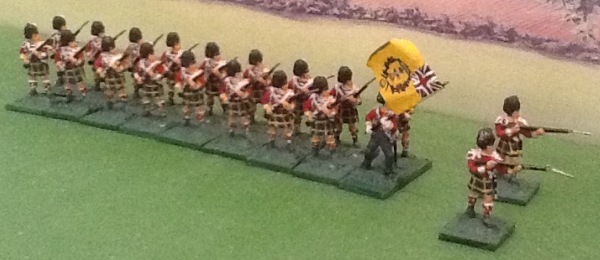
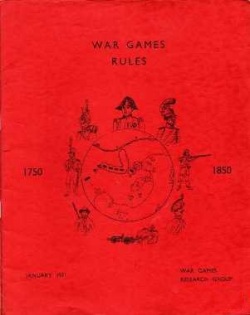
Between 1971 and 1973, I was based in Farnborough, in Hampshire, and most of us who went to the local North Farnborough Wargames Club used the 1971 WRG rules. Several of us decided that the 1:15 figure ratio in those rules produced far too large units, so we changed the figure ratio to 1:30, thereby halving the size of our units, and with a bit of re-basing and repainting we could have twice as many of them. Since then my Napoleonic Wargames figures have always been on that ratio.
They have also always been based in a single row of figures, since I have never understood the modern fashion of basing figures in two ranks. To me, base depth is already disproportionate, so why anyone wants to double that is beyond me. Still, everyone to his own, and I have had enjoyable games with other player’s figures based in that fashion.

A bit later, I came across Bruce Quarrie’s rules, in which he suggested the optimum ratio was 1:33. This was close enough to my 1:30 to to confirm my decision to model my armies on that ratio. He also suggested that the frontage issues of British (and their closest allies) operating in 2 ranks, whilst the French operated in 3 ranks, could be addressed by the spacing of the figures on their bases. For 1:72 figures, he proposed 12mm per figure for British and 8mm per figure for French. I liked this system, but found this a little too tight, so my wargame infantry are based at 15mm per figure if they really operated in 2 ranks, and 10mm per figure if they really operated in 3 ranks.
Since my Napoleonic figures were originally made for the Waterloo Campaign, I have based my Battalion strengths on the average in that campaign. There is a paper on Napoleonic Battalion Strengths in the Military Historical Research section.
I originally made all my infantry bases 20mm deep, but discovered that I could reduce this to 15mm, which helps to solve the disproportionate column depths, so I rebased all of my Napoleonic infantry onto that base depth.
Napoleonic Infantry formations
All wargames are a compromise between historical accuracy and playability. I prefer mine to be based on historical reality as far as it practicable.
Napoleonic warfare is often described as the era of line, column and square and it is worth considering what those actually mean on a Wargames table. Below is a British infantry battalion shown in line and various types of columns. It is only shown as having nine companies, since it is assumed that the Light Company would be converged into a Brigade Light Battalion (see the article on British Converged Light Battalions in the Military Historical Research Section of this website for more details of this).
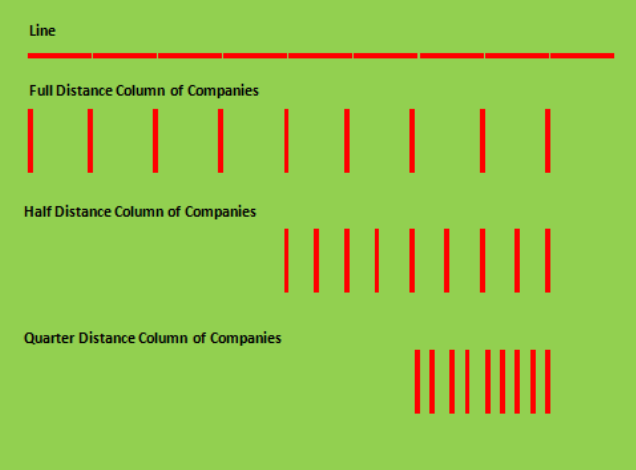
A full distance column was one where the length of the column from front to back was the same as the width of the battalion in line. From this formation the companies could simply wheel into line. Full distance columns were used on battlefields in the first half of the 18th Century, but by the Napoleonic era were only used for non-tactical route marches, normally not on a full company frontage, but by half company, quarter company, or by “fours”, in each case the column still being the same length from front to back as the width of the battalion in line, by having smaller gaps between the half companies, quarter companies or “fours”. There will be a paper on on infantry tactical formations posted on the Military Historical Review section in the near future.
Half distance columns were ones where the length of the column from front to back was the same as half the width of the battalion in line. They were hardly ever used by the British.
Quarter distance columns were ones where the length of the column from front to back was the same as quarter of the width of the battalion in line. This was the primary column used by the British for tactical battlefield movement, but hardly ever, if ever, by the French.
By way of comparison the columns used by a French battalion are as shown here. I have assumed that the French battalion is a post-1808 one and has all six companies present. I am also assuming that the frontage of a typical French company of 90 rank and file in three ranks is the same as that of a typical British company of 60 rank & file in two ranks.
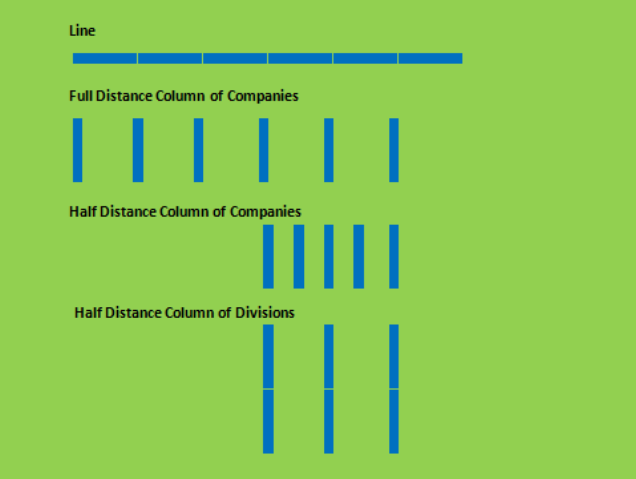
The French line is considerably shorter than the British one. French battlefield columns were almost always at half distance, whether on a Company frontage or Division (double company) frontage. The depth of a Half Distance Column of Companies is identical to that of a Half Distance Column of Divisions, and actually both of these are identical in depth to a British Quarter Distance Column of Companies.
There was one other form of column used by all nations, and that was a Close Column (French Colonne Serre) where there was only one pace between successive companies. It was particularly used as an assault formation into breaches in fortifications.
The reasons behind these particular tactical choices will be explained in more detail in a forthcoming article in the Military Historical Research section.
So what does this mean on the wargames table. Many wargamers like to base their figures by companies, and I am no exception. Because of figure ratios and the depth of the figures on the bases, it is impossible to portray the distinctions between half distance, quarter distance and close columns on the wargames table, unless one uses a figure ratio of 1:10, as Chef de Battalion did. The best that can be hoped for is to distinguish between full distance (non- tactical) Columns of Route and reduced distance Battlefield Columns. Even that distinction is difficult, if not impossible, for figures based in two ranks, which is why I dislike that basing system.
So this is what my British wargame battalions look like in line, full distance column and reduced distance battlefield column. The battalions are actually from Colborne’s Brigade at Albuera, from the top: 3rd Foot (Buffs), 31st Foot and 66th Foot. They are all Airfix figures.
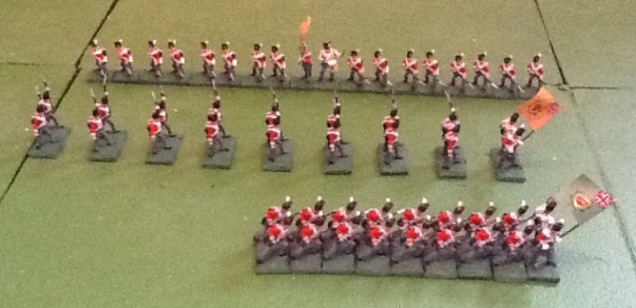
The full distance column could simply change into line by a wheel of each company.
The reduced distance column (representing the standard British quarter distance column) is more than twice as deep as it should be, but that is a compromise which I have to accept if I wish my wargame figures to be on a 1:30 ratio.
On the whole, I do not think that full distance columns have a place in a Napoleonic wargame, since they were only used for non-tactical movement, but if they were to be used (perhaps in an ambush scenario, where a battalion was caught unprepared for combat), then the companies could be placed a a movement base, such as the one below. This is a thin piece of card of company width, and full distance column length, with thicker card stuck on where the gaps should be between successive companies. Here the 42nd Foot (Black Watch) are in a Column of Route and there is a spare full distance column movement base in front of them to show how it was constructed.

This is what French battalions would look like in line, full distance columns and half distance columns, both by company and by division. These are 2nd, 3rd and 4th Swiss Regiments and the Neuchatel Battalion (Canaries). They are all converted from Hät Chasseurs, apart from some of their command stand figures.
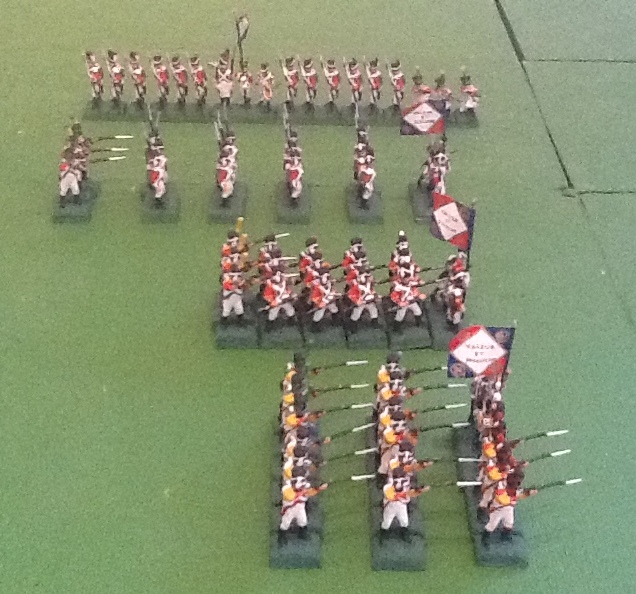
The half distance column of companies is a bit too deep, since its rear company should be level with the rear division of the Neuchatel Battalion. I do accept that most wargamers would not bother with the correct spacing of the Column of Divisions, so perhaps they should look like this:

That spacing is more like a Close Column (French Colonne Serre), but it could represent either. The compromise that a Column of Companies is too deep and a Column of Divisions not deep enough seems reasonable to me.
Whilst mentioning columns, I thought I would use my French wargame figures to show the difference between a French Column of Division and Column of Attack. It is simply a matter of the order of the companies within the column. I give all my French infantry company coloured pom-poms (slightly oversized), with the battalion command stand being the 1st Fusilier Company. Here you can see the 1st Battalions of 92nd and 93rd Ligne both advancing in Columns of Division.

The company layout is Grenadiers & 1st Fusiliers in front, followed by 2nd & 3rd Fusiliers in the middle and then 4th Fusiliers and Voltigeurs at the rear. When they deploy into line, as the 93rd Ligne is doing, the Grenadiers and 1st Fusiliers halt, and all the other companies turn left and march unil they clear the end of the front companies. They then turn right and march into line. It takes a bit of time.
Below you can see the same two battalions in Columns of Attack.

The company layout is 2nd and 3rd Fusiliers in front, followed by 1st & 4th Fusiliers in the middle and then Grenadiers and Voltigeurs at the rear. When they deploy into line, as the 93rd Ligne is doing, the 2nd and 3rd Fusiliers halt, and all the other companies outwards until they clear the end of the front companies. They then turn to face their front and march into line. Because they are deploying simultaneously on both flanks of the column it is faster.
From both Column of Division and Column of Attack, the company order when they complete the manoevre into line will be the same: Grenadiers, 1st Fusiliers, 2nd Fusiliers, 3rd Fusiliers, 4th Fusiliers and Voltigeurs
I would emphasise that Columns of Attack have nothing whatsoever to do with attacking in column, it is merely a device for forming line more quickly.
Squares are more of a problem. They could be formed from line, but took a long time to do so, at least 2 minutes, even for a well trained battalion. Squares formed from line would normally have a two company frontage on their front face. If formed from column, a square would have the same frontage as the column did. From a British quarter distance column, or a French half distance column, squares could be formed in less than 20 seconds, so that is why those columns were the preferred formations for battlefield movement whenever their was a threat from cavalry. I will post an article about squares on the Military Historical Research section in the near future.
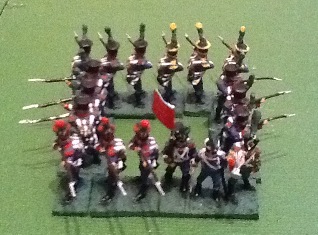
French 3 rank companies formed 3 rank faces to their squares, so arranging a French wargame battalion into square is relatively easy, as here with the 3rd Battalion 4th Legere..
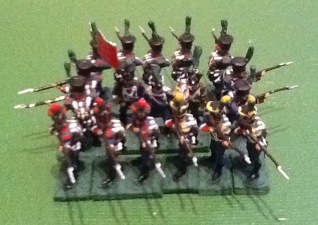
They did tighten up their formation when in square, so perhaps this can be indicated by placing the command stand in the centre of the square, and only having two figures facing outwards on each flank. There will only be five figures on the rear face, but I think that compromise is fine.
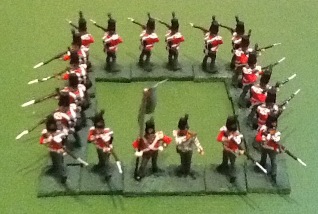
It is much more difficult to portray a British battalion in square. They should only be on a one or two company frontage, but if a British Battalion at a 1:30 ratio is arranged in square, as with the 51st Light Infantry here, it is impossible to show them in less than a three company frontage, or as a long oblong. They are shown here as occupying three times the area which they should be covering.

That can be improved a bit by putting their command stand into the middle of the square, but all that really does is to slightly reduce the lengths of the side faces of the square.
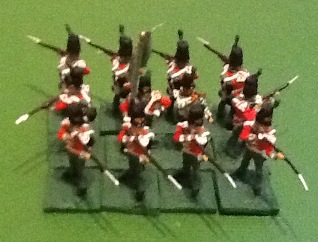
The British formed squares by their 2 rank companies doubling up to form 4 rank faces to the square. One way to portray this is to temporarily remove half of the figures from the faces of the square, which would reduce it to more accurate proportions. Only two of the four ranks fired when in square, so this also helps to indicate that. In this photo, I have left the command stand in the centre, so there are 10 figures (half of the battalion) on the faces of the square and two in the centre.
All of these problems of accurately portraying squares on the wargames table are made far worse if the figures are based in two ranks.
British Infantry
The average British line battalion in the Waterloo campaign was some 600 men, so at my 1:30 ratio I represent this with 20 figures, modelled as a 2 figure command stand (officer carrying Colour and drummer), plus a 2 figure grenadier company, 2 figure light company and seven other 2 figure centre companies. The grenadiers, lights and one centre company are on single bases (to facilitate figure removal, which I like) and the rest are based in pairs. I am assuming that 1mm = 2 foot, so a single figure on a 15mm frontage represents two ranks of 15 men in each rank. I know that the British 1792 Regulations specified a slightly closer 22 inch per man spacing (I have originals of almost all of the British Regulations, and copies of the rest), but I think that men would have needed to shake out into the slightly looser 24 inches per man in order to move.
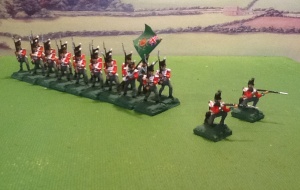
Here is 2nd Battalion 24th Foot advancing in column of companies. They are Airfix. Their left legs were originally straight out, in what to me seemed an unatural pose, so I have bent them to give a more natural marching pose. I use a convention for all of my Napoleonic units that light infantry figures are firing, so as to pick them out more easily. All of my Napoleonic flags are hand painted.
Although I have shown the Light Company in front of this battalion (and others like it below), in actual fact they would have been detached from their battalion into a converged Light Battalion, comprising all of the light companies in the Brigade, which then operated as a Brigade asset. For more details of how this worked, see my paper in the Military Historical Section Converged British Light Battalions.
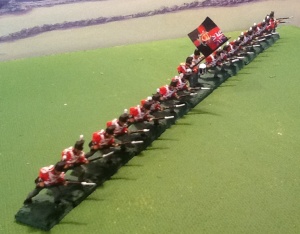
Here is 2nd Battalion 58th Foot in line. They are Airfix and were originally kneeling, but I converted them to crouching over their muskets by straightening their rear legs. The grenadiers are the same figures as the rest of their battalion, but with white plumes on their shakos to distinguish them from the white over red of the centre companies.
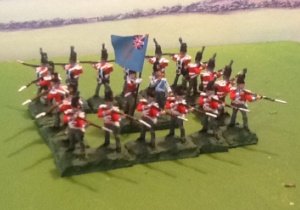
Here is the Chasseurs Britanniques in square. All figures are firing to easily identify them as light infantry (since I prefer rules which give additional firing factors to trained light infantry). I have welded their shakos into conical ones with central green plumes.
Almost all of my British Infantry are Airfix, with the line infantry in their Belgic shakos, which I use anachronistically for earlier Peninsular battles than that headdress was worn. I have a total of 40 battalions of British Line Infantry, all of those at Waterloo, and most of those at Salamanca and Albuera.
I have modelled my Fusilier Brigade, 1st & 2nd Battalions 7th Royal Fusiliers and 23rd Royal Welch Fusiliers, in their bearskin caps. I know that it is now accepted that they only wore these for parades in this era, but many Victorian artists portrayed them fighting in their bearskins, and I liked the look of them wearing this distinctive headress. I also had the ulterior motive that it enabled me to use 60 heads with Belgic shakos, to convert four more battalions of Airfix French Infantry into Portuguese wearing Barratinas. The bearskins are heads from Airfix AWI British Grenadiers.
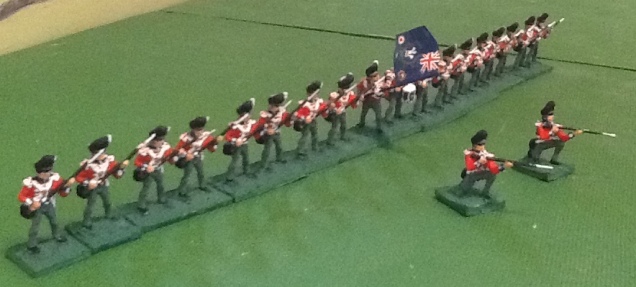

British Foot Guards averaged much higher strengths, so I have modelled them at 30 figures per battalion, 10 companies of 3 figures. I have four battalions of them, those at Waterloo. This shows the Coldstream Guards, one of my favourite units, both on the wargames table, and in real life when I met them on several occasions during my Army service. They are shown in two ranks of figures, which represents the 4 deep line which some of the Foot Guards battalions adopted at the end of the Battle of Waterloo, as a precaution against weak cavalry. Their King’s Colour is hand painted.
I have modelled some, but not all, British Light Infantry on that same 30 figure strength. I use the same Airfix British infantry, but have welded their shakos into conical ones. My large British Light Infantry are 43rd, 52nd and 71st. I have normal sized (20 figure ones) of 51st, 68th and Chasseurs Britanniques. Here the 71st Foot have formed in two half-battalion wings, as they did at Waterloo. At the end of that battle, they also formed a four deep line by bringing the rear wing up to join the front one. I give my light infantry flags whenever historically justified, but normally model these in a less obtrusive position (eg with the pole resting on the ground as here). My light infantry and rifles all have buglers rather than drummers.

My 95th Rifles are modelled as six large companies (3 figures each) as they were for Waterloo. Here they have deployed four companies as skirmishers, keeping two as a reserve. Again Airfix, but the officer has the top half of an Airfix British Hussar, so that he has a pellise.

My 5/60th Rifles are Revell British Infantry figures, actually my only non-Airfix British Infantry. Most of the battalion was split up by companies to different Brigades from 1809 onwards, but I have shown the complete battalion below (as they were at Roliça and Vimiero in 1808).
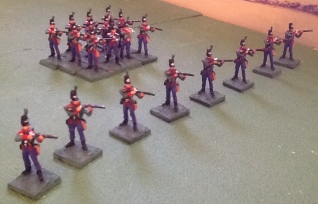
I bought a box of these Revell figures when Airfix stopped producing British Infantry, but then Hät reissued the Airfix figures, so I stuck with those. Some have been converted so that all are firing, apart from the command stand (officer and bugler), since I like all light infantry to be in a firing pose (some rules give extra factors for Light Infantry, so it makes identification easier).
My KGL were originally modelled as for Waterloo, when they reduced to six large companies (including grenadiers and lights), and their surplus officers and sergeants were attached to the Hanoverian landwehr. They are therefore modelled as 6 companies of 3 figures each. I have 6 KGL Line battalions and 2 KGL Light battalions. Those who served in the Peninsula have extra figures so that they can be shown there as normal 20 figure battalions.
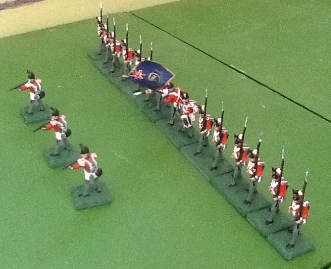
This is 1st Line Battalion KGL. The KGL originally only had 8 companies per battalion but had several rifle armed sharpshooters per company who were detached into a skirmisher screen. When they formed Light and Grenadier Companies in 1812, the Light Companies were entirely rifle armed. I cut the ends off muskets to indicate rifles.
The KGL Light Battalions wore uniforms very similar to British 95th Rifles, but I have painted them with grey trousers. They were about 50% armed with muskets and 50% armed with rifles.
British Allies
Hanoverians used four large companies per battalion, but operated tactically as 8 half-companies, so I have modelled them as a command base plus 7 centre bases. Hanoverians found their light infantry by detaching a few sharpshooters from each company (the KGL used the same system up to December 1811), so they had the equivalent of one more half-company (2 figures) of sharpshooters, which brings the total strength of my Hanoverian battalions to 18. Here you can see the Verden Feld (regular) Battalion. The officers have yellow (rather than the British crimson) sashes, and the soldiers have white over yellow plumes (although actually this was not universal, some still wearing British sashes and plumes). The flag is conjectural, based on black and white sketch which was apparently produced as a prototype for Hanoverian regular battalion flags, but I have shown it in the Verden battalion historically correct green facing colour. They are Airfix British Infantry.
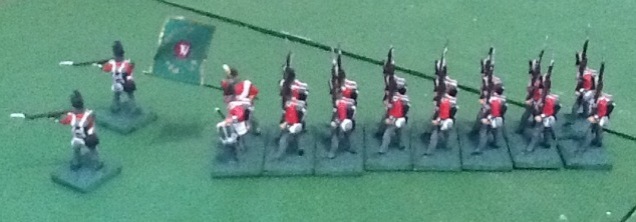
I have 5 regular Hanoverian Feld battalions, including two light. The Hanoverian Light Battalions (Luneburg and Grubenhagen) wear KGL Light uniforms but carry muskets, apart from their sharpshooters, who have rifles. I also have a half battalion of Kielmansegge’s Jägers (shown below).

The Kielmansegge’s Jägers are Airfix British Infantry, with their shakos welded into their Prussian style caps. Their small flag still exists, and I saw it in the former Hanoverian Royal Summer Palace at Schloss Marienburg, a few miles south of Hanover city. However all of the Hanoverian and KGL flags which were there have been auctioned off.
My Hanoverian Landwehr are also Airfix British infantry but have had their shakos welded into conical ones. Some officers and attached KGL personnel have Belgic shakos. Every Hanoverian landwehr battalion at Waterloo had 6 KGL officers and 6-7 KGL sergeants attached to it and I have represented this by a single KGL Sergeant, as on the right of this Gifhorn Hanoverian Landwehr battalion.
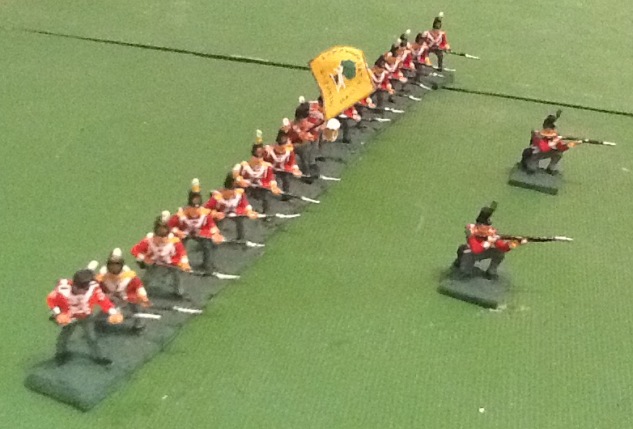
The Gifhorn flag also still exists, although in very poor condition, and is in the museum in that town. I have 4 Landwehr battalions (one Brigade) and I do have the figures to complete the last two Hanoverian Landwehr Brigades at Waterloo, but have not yet made them.
I have the complete Brunswick Corps (Division equivalent) of 8 battalions. They are all 20 figures, organised as 4 x 5 man companies. They are Airfix British bodies with Airfix French heads, apart from the Avant Garde Battalion, which has specially converted jaeger hats. I made these before Hät produced their figures. I also use the Lieb Regiment as the Brunswick Regiment in the Peninsula, and have 6 jaegers in their Peninsular uniform to add to them. Their drooping horsehair plumes are modelled with a pin stuck into the shako and plastic sprue welded on.
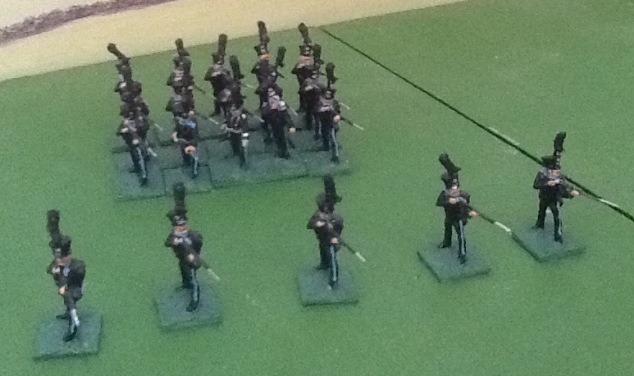
I have the complete 2nd Netherlands Division at Waterloo, a total of 10 battalions comprising Dutch, Belgian, Orange Nassau and Nassau troops. The Dutch and Belgians (and their Militia) are 18 figures per battalion (French organisation of 6 companies of 3, but spaced as British). The 7th Belgian Line (below) are Airfix British figures, with the bottom of their trousers welded into ankle boots.
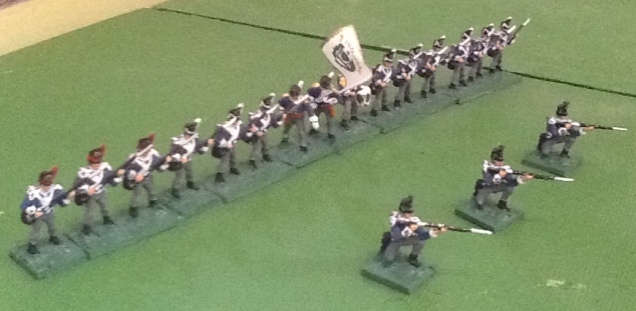
The 5th Netherlands Militia are also Airfix British, but with their shakos welded into conical ones.
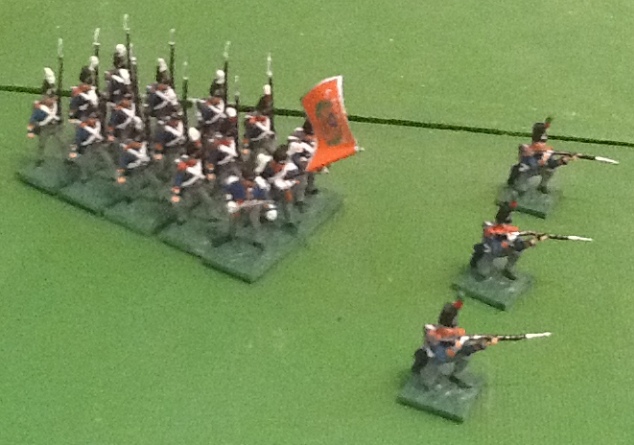
The Orange Nassau are 24 figures per battalion (6 companies of 4). They are Airfix British figures with French heads.
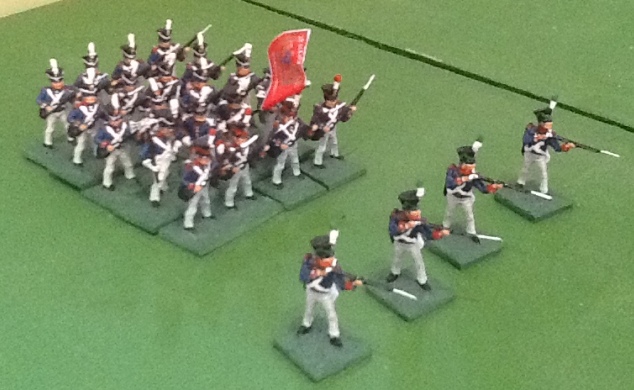
The 2nd Nassau (2 battalions) are Airfix French figures, 30 figures per battalion (6 companies of 5). I also have the independent Nassau contingent (1st Nassau Regiment) of three battalions, also 30 figures per battalion. I painted the latter with the off-white shako covers which several sources describe them wearing at Waterloo. I have assumed that all of these are using a French 3 rank system, therefore they are spaced at 10mm per figure. The Nassau Regiments certainly operated in 3 ranks when they were allied to the French in the Peninsula. The Prince of Orange ordered his Netherlands Army to adopt a British style 2 rank formation, but it is not clear whether that applied to his Nassau contingents.
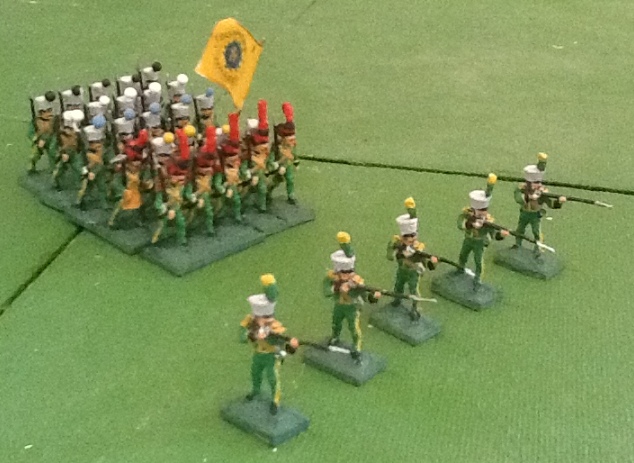
I have the figures to make the 3rd Netherlands Division but have not yet made it.
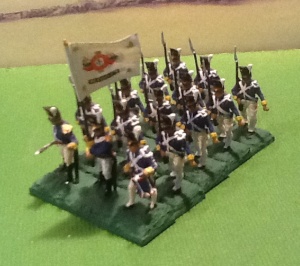
My Peninsular allied troops include five regular Portuguese Brigades, each of five battalions (4 line and one light), plus the two light (Caçadores) battalions in the British Light Division. These Portuguese battalions are each 5 companies of 3 figures. All of these Portuguese figures are Airfix French with British heads. I know they changed to conical shakos from about 1811, but I like them in their barratinas. I have the figures to make two more brigades of Portuguese infantry.
Here is a Portuguese Caçadores battalion deployed as skirmishers. Two companies have been kept as a close order reserve. The central kneeling figures are rifle armed Atritadores.

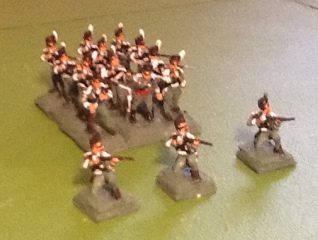
Two of the Portuguese Light Battalions have been modelled as 1st and 2nd battalions of the Loyal Lusitanian Legion, but I have plans to have alternative figures for them in their new uniforms as 7th and 8th Caçadores. Here is 1st Battalion LLL advancing in quarter distance column, as it did on the left flank of the Fusilier Brigade at Albuera.
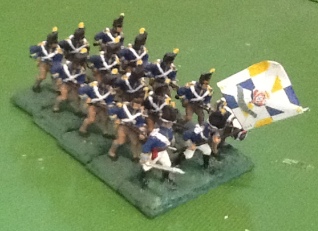
I have two Portuguese Militia Brigades (10 battalions, with same organisation as regulars, but no light battalions). I painted these with brown “local cloth” trousers, to distinguish them from the regulars. This is the Chaves Militia. The officers are wearing round hats, with a central fur crest.
I also have four Portuguese Ordenanza “Brigades”, reproducing the units involved in the valiant week long defence of Amarante in 1809 (I have been there and it was well worth the trip). Each “Brigade” is like a large battalion, subdivided into 8 companies. One has 64 figures (8 companies of 8), two of 48 figures (8 companies of 6) and one of 32 figures (8 companies of 4). These are all Airfix American Civil War Confederate figures, painted in mixed civilian clothes, but their Officers and NCOs are in green with British shakos. Half of each of these “Brigades” have muskets, and the rest have pikes, made from hairpins. This is the Viana Ordenanza (48 figures), the front rank having muskets and the rear rank having pikes, representing a four rank formation. Alternatively they could be organised in a 17th Century system of the pikes in the centre and two wings of musketeers.
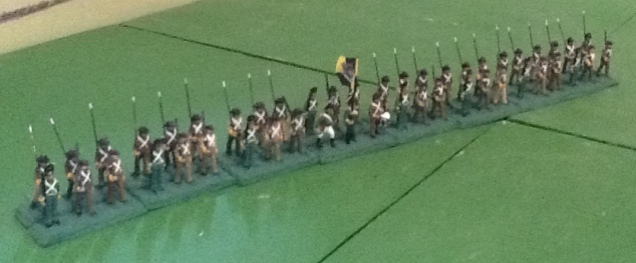
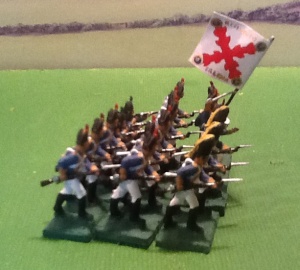
I also have Blake’s complete Spanish Army at Albuera, including Carlos d’Espana’s brigade, a total of 22 battalions, each of 18 figures (6 companies of 3). These are a complete mixture of figures, some Esci 1805 Prussians, some Esci/Italeri French, some Hat British Marines. The battalion in this picture is the Irlanda Regiment, and is Esci 1805 Prussians.
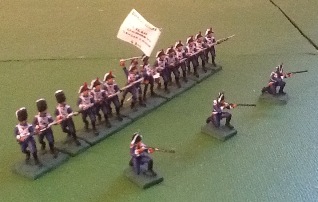
Here is the 4th Battalion Reales Gardes. They have also been converted from Esci 1805 Prussians. Both their grenadiers, and those of the Irlanda Regiment above, are headswaps with Airix French Imperial Guard Grenadiers, enabling the French Imperial Guard 3rd and 4th battalions to have some men in bicornes.
It was a period of massive change to Spanish uniforms. A few regiments still had old white uniforms, but most had blue or brown. There were even some in green (like Regiment de la Patria) and red ( Cazadoes de Barbastro). Furthermore they had a wide variety of headgear, including bicorne hats, bell-topped shakos, conical shakos, top hats and even one regiment in a “bonnet de police”. Some grenadiers were still wearing their bearskins with long flammes. This makes a really eclectic and attractive mixture.
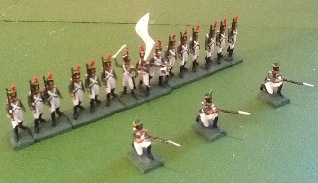
Here is the Regiment de la Patria, in their green uniforms. They are converted from Esci French Line Infantry.
Below is a Spanish Brigade, commanded by Brigadier General Carlajan, a converted Esci Polish lancer officer.
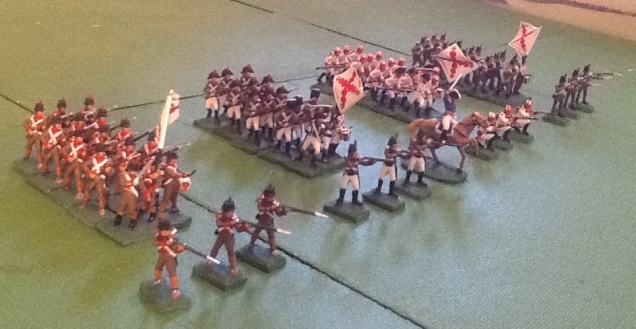
The closest regiment is 1st Battalion Provincial Catelanes. They are converted Hät British Marines (in their round top hats). I have painted them witb leather gaiters and sandals.
The next regiment is Regiment de Lena. They are in brown uniforms with bicornes and are converted from Esci 1806 Prussians.
The third regiment is Regiment de Castropol. I have shown them in white with their distinctive “bonnets de police”, not unlike those worn by the modern Spanish Army. They are converted from Esci 1806 Austrians (helmet welded into bonnet). Their officer has a bicorne and their grenadiers have bearskins.
The fourth regiment is the Regiment Cangas de Tineo. I have shown them in brown uniforms with conical shakos. They are converted from Hät British Light Infantry.
French Infantry
My French Infantry, and their allies, are based as 10mm per figure. Since my ground scale is 1mm = 2 foot, this means that each French figure represents 3 ranks of 10 men at 24″ spacing. I have taken my French line battalions at their average strength in the Waterloo Campaign, which was 540 men, which conveniently gives 18 figures (6 companies of 3). This means that a French 3 figure company has exactly the same frontage as a British 2 figure company, which is right for Waterloo. All of my French Line battalions are on this organisation, even if I use them in the Peninsula, when they may have had 9 companies in the early years. I have the complete 2nd Corps at Waterloo (33 battalions). They are all Airfix French.
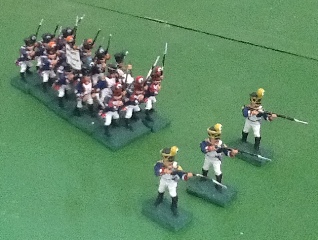
Only the 1st Battalions of my French Infantry have Eagles, the 2nd, 3rd and 4th battalions carrying fanions of white, red or blue, respectively. They are in a column of companies, since when a six company French battalion deployed its voltigeurs as skirmishers, it could no longer form a column of divisons (on a 2 company front), or if it did so was incapable of forming square.
There will be a future article on squares in the Military Historical Research section elaborating on this.
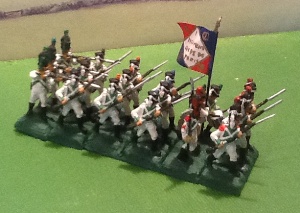
I also have a number of battalions which were in the Peninsula, including Garde de Paris (shown here). They are Hät French Chasseurs
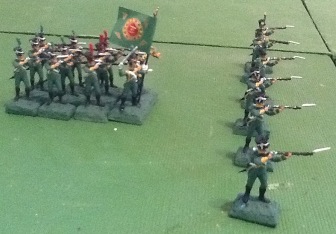
My Legion Irlandaisse, are modelled as Light Infantry as ahown here. They are Italeri French Infantry. They have thrown two companies forward into a skirmish line.
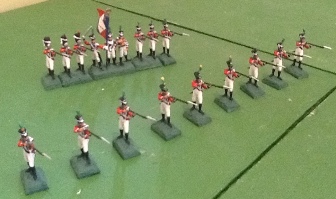
I have a Legion Hanovrienne (shown here) and a Regiment de Prusse and Legion de Midi, all Italeri French Infantry, and all organised as light infantry.
My Peninsular French Army includes three Swiss battalions and the Neuchatel battalion (the latter modelled as light infantry). These are mostly Hät French Chasseurs, although a few other figures have been used on the command stands, as in the 2nd Swiss Regiment below, where with hindsight their command stand figures look a little undersized.

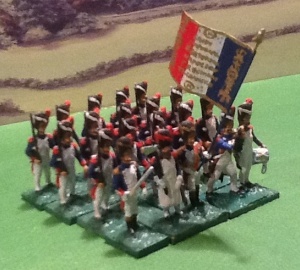
I also have the complete French Imperial Guard at Waterloo, 22 infantry battalions each of 20 figures (4 companies of 5). The Old Guard are Airfix French Imperial Guard. Their flags are hand painted, as are all of my Napoleonic flags.
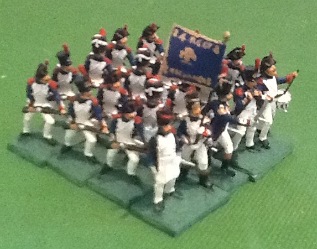
The 3rd and 4th Regiments of both Grenadiers and Chasseurs include a number of figures in shakos and bicorne hats. The latter were head swaps with Esci/Italeri 1805 Prussians, the bearskins being used to convert some of those figures to Spanish grenadiers. The Young Guard are Airfix French.
I have the figures to make the French 1st and 6th Corps at Waterloo
French Allies
The foreign regiments which I mentioned above were integrated into the French Army, but I also have some French Peninsular allies.
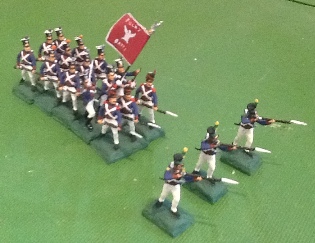
I have a Polish infantry brigade. This is six battalions, on French organisation. They are Esci/Italeri French figures. The grenadiers have bearskins (head swap with some French Imperial Guard 3rd and 4th Regiments mentioned above). The light companies have been left in their shakos. All of the fusilier companies have czapas, head swaps from Esci/Italeri Polish lancers, enabling the latter to be used as Prussians.
I also have 2 Hesse-Darmstadt battalions, 2 Baden battalions, 1 Frankfurt battalion and 2 Dutch battalions, all organised as French.

I also have one brigade of King Joseph’s Spanish troops, and the figures to make a second. This is King Joseph’s Spanish Guard Grenadiers. The figures are Airfix French Imperial Guard, but painted with brown “local cloth” trousers.
Prussian Infantry
Several years ago, before any manufacturer made Prussian figures, I began to create a Prussian Army. At present it is a Prussian Brigade, Division by anyone else’s standards, comprising three regiments of three battalions each (total 9 battalions). One is regular and two are Landwehr. They were all in IV Korps at Waterloo, but not in the same Brigade.
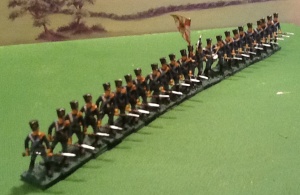
Every battalion is 24 figures, organised as 8 half-companies (zugs) of 3 figures. One base is a command base. The regular regiment (15th Infantry), one of its Musketeer battalions shown here, is converted from Esci French, mainly by the addition of a welded plastic rolled shoulder blanket over their left shoulder.
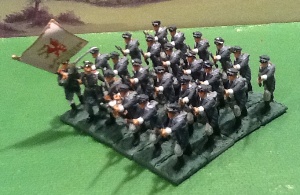
The Landwehr regiments were converted from Esci Crimean Russians mainly by adding a peak to their caps, plus rolled shoulder blankets over their left shoulders. A musketeer battalion of the 2nd Pommeranian Landwehr is shown here. My 15mm depth of bases makes this close column look really tight.
All are based on a system which I copied from one of the members of the Newbury and Reading Wargames Club in the 1990s.
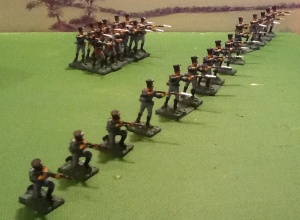 They are in threes on a 30mm frontage base, the same as the French, but the middle figure is removable, so converting the two remaining figures to the same frontage as British. The middle figures can then be used as skirmishers, or to extend the battalion frontage. This represents the Prussian use of their third rank. The only problem is that the spacing of the two figures left on each base looks a little odd.
They are in threes on a 30mm frontage base, the same as the French, but the middle figure is removable, so converting the two remaining figures to the same frontage as British. The middle figures can then be used as skirmishers, or to extend the battalion frontage. This represents the Prussian use of their third rank. The only problem is that the spacing of the two figures left on each base looks a little odd.
Each regiment also has a 3 figure volunteer jäger detachment, the kneeling figures on the right of the 15th Infantry Fusilier battalion shown above.
I have the figures to complete all of the Prussian IV Korps at Waterloo, plus those elements of I Korps and II Korps which actually reached the battlefield.
Austrian Infantry
I do have all of the figures to make an 1809 Austrian Army of 33 battalions, line of 36 figures, Grenadiers and Grenzer of 24 and Landwehr of 18. I have not made any of these yet.